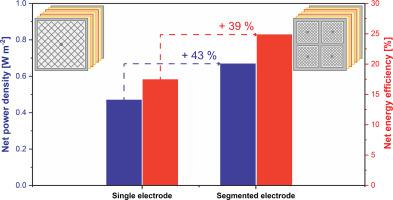当前位置:
X-MOL 学术
›
Desalination
›
论文详情
Our official English website, www.x-mol.net, welcomes your
feedback! (Note: you will need to create a separate account there.)
Electrode segmentation in reverse electrodialysis: Improved power and energy efficiency
Desalination ( IF 8.3 ) Pub Date : 2020-10-01 , DOI: 10.1016/j.desal.2020.114604 Catarina Simões , Diego Pintossi , Michel Saakes , Zandrie Borneman , Wim Brilman , Kitty Nijmeijer
Desalination ( IF 8.3 ) Pub Date : 2020-10-01 , DOI: 10.1016/j.desal.2020.114604 Catarina Simões , Diego Pintossi , Michel Saakes , Zandrie Borneman , Wim Brilman , Kitty Nijmeijer

|
Abstract Reverse electrodialysis harvests energy from salinity gradients establishing a renewable energy source. High energy efficiencies are fundamental to up-scale the process and to minimize feedwater pre-treatment and pumping costs. The present work investigates electrode segmentation to strategically optimize the output power density and energy efficiency. Electrode segmentation allows the current density to be tuned per electrode segment. Segmentation experiments were performed with a dedicated electrode configuration in a cross-flow stack using a wide range of residence times. Moreover, an experimentally validated model was extended and used to further compare single and segmented electrode configurations. While operating the electrode segments, the highest efficiencies were obtained when considering the overall power, i.e. not maximized by segment. Results show that at a given net power density (0.92 W·m−2), electrode segmentation increases the net energy efficiency from 17% to 25%, which is a relative increase of 43%. Plus, at 40% net energy efficiency the net power output for a segmented electrode configuration (0.67 W·m−2) is 39% higher than in a single electrode configuration. Higher power density reduces capital investment and higher energy efficiency reduces operating costs. Electrode segmentation increases these parameters compared to a single electrode and can be potentially applied for up-scaling.
中文翻译:

反向电渗析中的电极分段:提高功率和能源效率
摘要 反向电渗析从盐度梯度中收集能量,建立可再生能源。高能效是扩大工艺规模和最小化给水预处理和泵送成本的基础。目前的工作研究了电极分割,以战略性地优化输出功率密度和能源效率。电极分段允许调整每个电极分段的电流密度。分段实验是在横流堆栈中使用专用电极配置进行的,使用范围很广。此外,一个经过实验验证的模型被扩展并用于进一步比较单个和分段电极配置。在操作电极段时,考虑总功率时获得最高效率,即 没有按段最大化。结果表明,在给定的净功率密度 (0.92 W·m-2) 下,电极分割将净能效从 17% 提高到 25%,相对提高了 43%。此外,在 40% 的净能效下,分段电极配置 (0.67 W·m-2) 的净功率输出比单电极配置高 39%。更高的功率密度减少了资本投资,更高的能源效率降低了运营成本。与单个电极相比,电极分割增加了这些参数,并且可以潜在地应用于放大。在 40% 的净能效下,分段电极配置 (0.67 W·m-2) 的净功率输出比单电极配置高 39%。更高的功率密度减少了资本投资,更高的能源效率降低了运营成本。与单个电极相比,电极分割增加了这些参数,并且可以潜在地应用于放大。在 40% 的净能效下,分段电极配置 (0.67 W·m-2) 的净功率输出比单电极配置高 39%。更高的功率密度减少了资本投资,更高的能源效率降低了运营成本。与单个电极相比,电极分割增加了这些参数,并且可以潜在地应用于放大。
更新日期:2020-10-01
中文翻译:

反向电渗析中的电极分段:提高功率和能源效率
摘要 反向电渗析从盐度梯度中收集能量,建立可再生能源。高能效是扩大工艺规模和最小化给水预处理和泵送成本的基础。目前的工作研究了电极分割,以战略性地优化输出功率密度和能源效率。电极分段允许调整每个电极分段的电流密度。分段实验是在横流堆栈中使用专用电极配置进行的,使用范围很广。此外,一个经过实验验证的模型被扩展并用于进一步比较单个和分段电极配置。在操作电极段时,考虑总功率时获得最高效率,即 没有按段最大化。结果表明,在给定的净功率密度 (0.92 W·m-2) 下,电极分割将净能效从 17% 提高到 25%,相对提高了 43%。此外,在 40% 的净能效下,分段电极配置 (0.67 W·m-2) 的净功率输出比单电极配置高 39%。更高的功率密度减少了资本投资,更高的能源效率降低了运营成本。与单个电极相比,电极分割增加了这些参数,并且可以潜在地应用于放大。在 40% 的净能效下,分段电极配置 (0.67 W·m-2) 的净功率输出比单电极配置高 39%。更高的功率密度减少了资本投资,更高的能源效率降低了运营成本。与单个电极相比,电极分割增加了这些参数,并且可以潜在地应用于放大。在 40% 的净能效下,分段电极配置 (0.67 W·m-2) 的净功率输出比单电极配置高 39%。更高的功率密度减少了资本投资,更高的能源效率降低了运营成本。与单个电极相比,电极分割增加了这些参数,并且可以潜在地应用于放大。











































 京公网安备 11010802027423号
京公网安备 11010802027423号